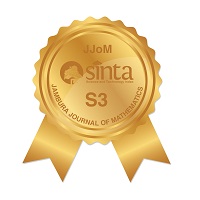Sistem Chaos Model Risiko Keuangan: Analisis Dinamik
Abstract
Keywords
Full Text:
PDFReferences
S. Vaidyanathan, A. Sambas, M. Mamat, and W. Mada Sanjaya, "A new three-dimensional chaotic system with a hidden attractor, circuit design and application in wireless mobile robot" Archives of Control Sciences, vol. 27, no. 4, pp. 541-554, dec 2017, doi: http://dx.doi.org/10.1515/acsc-2017-0032.
A. Sambas, S. Vaidyanathan, T. Bonny, S. Zhang, Sukono, Y. Hidayat, G. Gundara, and M. Mamat, "Mathematical Model and FPGA Realization of a Multi-Stable Chaotic Dynamical System with a Closed Butterfly-Like Curve of Equilibrium Points" Applied Sciences, vol. 11, no. 2, p. 788, jan 2021, doi: http://dx.doi.org/10.3390/app11020788.
M. J. Jacobson and U. Wilensky, "Complex Systems in Education: Scientific and Educational Importance and Implications for the Learning Sciences" Journal of the Learning Sciences, vol. 15, no. 1, pp. 11-34, jan 2006, doi: http://dx.doi.org/10.1207/s15327809jls1501 4.
J. Li and M. Kwauk, "Exploring complex systems in chemical engineering"”the multi-scale methodology" Chemical Engineering Science, vol. 58, no. 3-6, pp. 521-535, feb 2003, doi: http://dx.doi.org/10.1016/S0009-2509(02)00577-8.
Sukono, A. Sambas, S. He, H. Liu, S. Vaidyanathan, Y. Hidayat, and J. Saputra, "Dynamical analysis and adaptive fuzzy control for the fractional-order financial risk chaotic system" Advances in Difference Equations, vol. 2020, no. 1, p. 674, dec 2020, doi: http://dx.doi.org/10.1186/s13662-020-03131-9.
Loid Arseni Karchava, "Theoretical basics of business communication and Its connection with other sciences" New Economist, vol. 4, pp. 69-71, 2018.
C. H. Hommes, "Periodic, almost periodic and chaotic behaviour in Hicks' non-linear trade cycle model" Economics Letters, vol. 41, no. 4, pp. 391-397, jan 1993, doi: http://dx.doi.org/10.1016/0165-1765(93)90211-T.
R. H. Day, "Irregular Growth Cycles" The American Economic Review, vol. 72, no. 3, pp. 406-414, 1982.
J. A. Scheinkman and B. LeBaron, "Nonlinear Dynamics and Stock Returns" The Journal of Business, vol. 62, no. 3, pp. 311-337, 1989.
W. A. Barnett, A. Gallant, M. J. Hinich, J. A. Jungeilges, D. T. Kaplan, and M. J. Jensen, "A single-blind controlled competition among tests for nonlinearity and chaos" Journal of Econometrics, vol. 82, no. 1, pp. 157-192, jan 1997, doi: http://dx.doi.org/10.1016/S0304-4076(97)00081-X.
G. Feichtinger and M. Kopel, "Chaos in nonlinear dynamical systems exemplified by an R and D model" European Journal of Operational Research, vol. 68, no. 2, pp. 145-159, jul 1993, doi: http://dx.doi.org/10.1016/0377-2217(93)90299-3.
Y. Ma and W. Li, "Application and research of fractional differential equations in dynamic analysis of supply chain financial chaotic system" Chaos, Solitons and Fractals, vol. 130, p. 109417, jan 2020, doi: http://dx.doi.org/10.1016/j.chaos.2019.109417.
Q. Gao and J. Ma, "Chaos and Hopf bifurcation of a finance system" Nonlinear Dynamics, vol. 58, no. 1-2, pp. 209-216, oct 2009, doi: http://dx.doi.org/10.1007/s11071-009-9472-5.
B. Subartini, F. Sukono, S. Vaidyanathan, A. Sambas, and S. Zhang, "Multistability in the Finance Chaotic System, Its Bifurcation Analysis and Global Chaos Synchronization via Integral Sliding Mode Control" IAENG International Journal of Applied Mathematics, vol. 51, no. 4, pp. 995-1002, 2021.
K. Benkouider, T. Bouden, A. Sambas, B. Lekouaghet, M. A. Mohamed, S. Ibrahim Mohammed, M. Mamat, M. A. H. Ibrahim, and M. Z. Ahmad, "A new 10-D hyperchaotic system with coexisting attractors and high fractal dimension: Its dynamical analysis, synchronization and circuit design" PLOS ONE, vol. 17, no. 4, p. e0266053, apr 2022, doi: http://dx.doi.org/10.1371/journal.pone.0266053.
X. Zhao, Z. Li, and S. Li, "Synchronization of a chaotic finance system" Applied Mathematics and Computation, vol. 217, no. 13, pp. 6031-6039, mar 2011, doi: HTTP: //dx.doi.org/10.1016/j.amc.2010.07.017.
A. Sambas, S. Vaidyanathan, S. Zhang, Y. Zeng, M. A. Mohamed, and M. Mamat, "A New Double-Wing Chaotic System With Coexisting Attractors and Line Equilibrium: Bifurcation Analysis and Electronic Circuit Simulation" IEEE Access, vol. 7, pp. 115 454-115 462, 2019, doi: http://dx.doi.org/10.1109/ACCESS.2019.2933456.
A. Sambas, S. Vaidyanathan, E. Tlelo-Cuautle, B. Abd-El-Atty, A. A. A. El-Latif, O. Guillen-Fernandez, Sukono, Y. Hidayat, and G. Gundara, "A 3-D Multi-Stable System With a Peanut-Shaped Equilibrium Curve: Circuit Design, FPGA Realization, and an Application to Image Encryption" IEEE Access, vol. 8, pp. 137 116-137 132, 2020, doi: http://dx.doi.org/10.1109/ACCESS.2020.3011724.
DOI: https://doi.org/10.34312/jjom.v4i2.13808
Copyright (c) 2022 Siti Hadiaty Yuningsih, Sukono Sukono, Endang Rusyaman

This work is licensed under a Creative Commons Attribution-NonCommercial 4.0 International License.
Jambura Journal of Mathematics has been indexed by
Jambura Journal of Mathematics (e-ISSN: 2656-1344) by Department of Mathematics Universitas Negeri Gorontalo is licensed under a Creative Commons Attribution-NonCommercial 4.0 International License. Powered by Public Knowledge Project OJS.
Editorial Office
Department of Mathematics, Faculty of Mathematics and Natural Science, Universitas Negeri Gorontalo
Jl. Prof. Dr. Ing. B. J. Habibie, Moutong, Tilongkabila, Kabupaten Bone Bolango, Gorontalo, Indonesia
Email: [email protected].



















